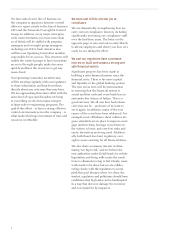JP Morgan Chase 2012 Annual Report Download - page 19
Download and view the complete annual report
Please find page 19 of the 2012 JP Morgan Chase annual report below. You can navigate through the pages in the report by either clicking on the pages listed below, or by using the keyword search tool below to find specific information within the annual report.
17
creating money (called Quantitative Easing) to
keep rates low and foster a stronger recovery.
For the most part, these policies have helped
the world economy recover – particularly
in the United States. But this medicine is
untested, and it may have severe aftereects.
This especially is true if fiscal policy makes
it increasingly harder for central banks to
slowly remove some of the monetary stim-
ulus. Good fiscal policy and any policies that
create growth will make the central banks’
job easier. Higher interest rates and a little
bit of inflation won’t matter much if we have
strong job growth, good profitability and
general prosperity.
We don’t know the outcome of all these
eorts. While it is entirely possible that we
will manage through the process without
too much suering, there also are some
fairly coherent arguments that suggest there
could be significant negative consequences.
We cannot ignore this possibility and must
safeguard against unintended and adverse
outcomes. One such scenario would be
rapidly raising rates without strong growth.
In the recent past, in 1994 and 2004, interest
rates, both short term and long term, rose
about 300 basis points within approxi-
mately a one-year period. In 1994, such
action was unexpected, and it caused real
damage for many who were unprepared
(i.e., the failure of Orange County and
significant financial losses at several finan-
cial and non-financial institutions). In 2004,
the increase in rates was more expected –
institutions probably had additional tools at
their disposal to manage it, and the damage
was far more limited.
Although we are not predicting it, we need to
be prepared for rapidly rising rates, poten-
tially even worse than we have seen in recent
history. One of the ways we do this is to posi-
tion our company – if all things are equal –
so we can benefit from rapidly rising interest
rates. As we currently are positioned, if rates
went up 300 basis points, our pre-tax profits
would increase by approximately $5 billion
over a one-year period. Remember, however,
that all things are not equal, and that $5
billion of improved income should be looked
at as an additional cushion to protect us from
other bad outcomes. You should know that
it costs us a significant amount of current
income to be positioned this way. But we
believe it is better to be safe than sorry.
The needs of our clients are substantial and
growing
In the years to come, the needs of our clients
and customers will not only grow but will
become more global and complex. This
includes companies’ needs for financing
– loans, equity, debt and trade – and stra-
tegic advice; investors’ needs for execution,
research and best prices; and individuals’
needs for asset management, mortgages,
credit and financial advice. Lots of things
will change – products, pricing, new tech-
nologies – but the needs of our clients for
our services and advice will be as strong as
ever. Our bank is uniquely positioned to help
clients benefit from those opportunities and
overcome those challenges. The following
examples highlight just how large those
needs will be:
• Ourissuerandinvestorclientswillhave
large and growing capital and investing
needs in the future. McKinsey estimates
that corporate equity and debt issuer
demand could grow 25%-30% over the
next five years, while global investor client
demand could grow 20%-25% by 2017.
These needs will drive real underlying
growth of the corporate and investment
banking business. JPMorgan Chase is in
the sweet spot because much of the growth
will be with our clients – large, often
multinational companies, government-
related entities and large global investors.
Our role as an underwriter of securities,
as a provider of payment services and as a
market maker places us right in the center
of key money flows.
• Opportunitiesforbusinessestogrowglob-
ally never have been greater. More and more
companies of all sizes are conducting busi-
ness cross border. Even in our U.S. Middle
Market business, international expertise
is becoming an essential service. All these
companies need the right partner – and one
with global capabilities and perspective – as
they enter unfamiliar territory.
























